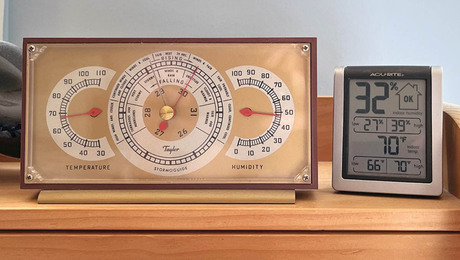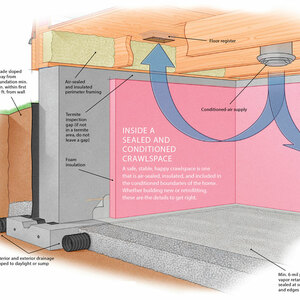I am looking to start a discussion on retrofit insulation projects for rowhouses. In my city (Baltimore, mixed humid climate) majority of homes are rowhouses built between 1880-1950. Typical construction is brick with floor joists set into beam pockets. Double wythe or single wythe masonry walls divide the homes. Exterior walls usually consist of double wythe brick with interior plaster applied directly to it. Majority of roofs are flat “hot roofs” (most are not vented) with one or two skylights. The only original insulation usually found in these home is loose insulation in the rafter cavities. Current standard procedure is to frame in the interior walls and install kraft faced fiberglass batts. But I know from experience in living in un-rehabbed and “rehabbed” homes that performance with these methods is lacking.
So I would like to look at different ways to address the poor performance of these homes in two scenarios: a full-gut rehab and a less invasive remodel. I have been doing my own research on insulating/ building science for some time now and seems that the first step to improving performance is to eliminate air leakage and then insulate. It also seems that the most efficient places to start are at the bottom of the home (foundation, basement) and at the top (attic). I would like to address the air barrier / insulation issue in a single step with rigid foam. Here are some rough ideas I am playing with, starting with the roof (any feedback would be appreciated):
1.) Existing roof = flat, with torch down rubber, 15×55. No ventilation considerations are in place. Previous owner installed kraft faced batts of r-19 and sheetrocked right to the rafters. Roof has a skylight (the old school kind: pyramind shape with a vent flap at the top) and several mechanical penetrations. I would like to install 4-6″ of XPS rigid foam, or as much as I can afford with reasonable payback time, taped and sealed around all penetrations. Can I go directly over the rubber roof? I have seen commercial details like this where the waterproof membrane is below the insualtion. The insulation is then held down by stone. I like this detail but am not willing to add all that stone given my existing framing. Is there another way to hold down the foam without compromising my roof surface with a lot of penetrations? Would this plan provide considerable results / improved performance?
Do I need to strip my roof, add foam / sheathing and reroof? A complete tearoff would provide the best opportunity to air seal, blow-in insualtion and then resheath and foam but I don’t necesarily have the time/resources for it. I also need to consider how I would transition from roof to wall foam. I am thinking I would rigid foam the interior side of the brick at the front of the house (to preserve the facade) and the frame and batt insualte with unfaced fiberglass.
I know I’m getting into a lot here but any feedback would be appreciated. For example:
1. Most efficient starting point (whether it is the roof or not)
2. Other ways to address the roof project
3. Experiences in similar projects (ideally some with tested results)
Thanks All


















Replies
Sounds like you're headed in the right general direction, but you're starting from one of the ugliest scenarios imaginable.
I'd be really careful about the roof -- whatever you do is apt to increase the propensity to leak. It all needs to be carefully planned by someone who REALLY knows flat roofs.
You need to be wary of trapping moisture in the area of the joist pockets -- rotting out the joist ends would not be a good thing to do.
It does occur to me, though, that this style of construction is incredibly common along the East Coast and up into parts of Canada (Toronto I know for sure). So there should be a lot of experience out there in dealing with it -- probably even some dedicated books, web sites, and/or organizations.
Here's an interesting thread
on a related topic:
http://forums.jlconline.com/forums/showthread.php?t=54561 and post #7 is the most relevant to your project
Another take on the same story:
http://inspectorsjournal.com/forum/topic.asp?TOPIC_ID=13082
Interesting links. Luckily my home, which I am using the example, has all joists in pockets of "party walls". Interior walls that are exposed to as many leak / moisture scenarios.
Exterior is all brick, 2 wythes thick from the early 1900's. I see issues with possibly adding rigid foam to the interior of these walls. At this point they are able to dry to the interior through the plaster. Would EPS applied to the interior still allow mositure to dry to the interior enough to avoid issues?
I know very little
about brick buildings. Been living on the left coast for most of my career. I'm guessing that you will be able to dig up real-world proven retrofit details fairly easily.
My 2 cents. Sounds like the roof is 'normal' to me. No venting for your situation. I've heard/seen ballasted roofing systems, but the insulation is not on top of the roofing, it is underneath. You cannot use existing roofing in this situation (assuming it's not made for ballast ... but you hinted right ... the roof structure may not be suitable. A ballasted system must be fully designed.
No such thing as a 'torch down' and "rubber" roof. Rubber and torches don't mix well. Torch down systems are usually a form of roll roofing materials and modified bitumen products, not rubber. If your roof and insulation are in good condition, not sure about efforts to increase the insulation ... it is chipping away at a very small part of the energy picture. Your first R-19 has made a huge dent in heat loss, and your next 2, 3, + inches of rigid will chip away at only small percentages of the loss.
If you HAVE to replace the roofing, though, I'd recommend adding rigid and then roofing over w/ e.g. monolithic style roofing (e.g. PVC or EPDM, etc). Add insulation as you can afford it. However, adding insulation thickness may affect your required parapet height (fire code) and you MAY not be able to do it. Also you may have a detail issue w/ e.g. the skylight depending on it's configuration/construction.
If you are worried about moisture issues inside the existing roof construction, you should check for damage. But the key to success in this roof is good ventilation/exhaust systems that control the moisture. Generally, there shouldn't be moisture damage as largely there is no path for air flow to really cause it. Drywall attached to the bottom of the joists is a good thing. Assuming you have minimal penetrations of the ceiling, you generally should have few worries. You do have few penetrations of the roofing, it sounds, so there may be no issues there.
Whatever you do roofing wise ... do it right and hire someone that knows what he's doing, if that is your choice. 'Flat' roofs can be problematic if not done properly and maintained correctly. If done right, they are great!! Most are not 'vented'